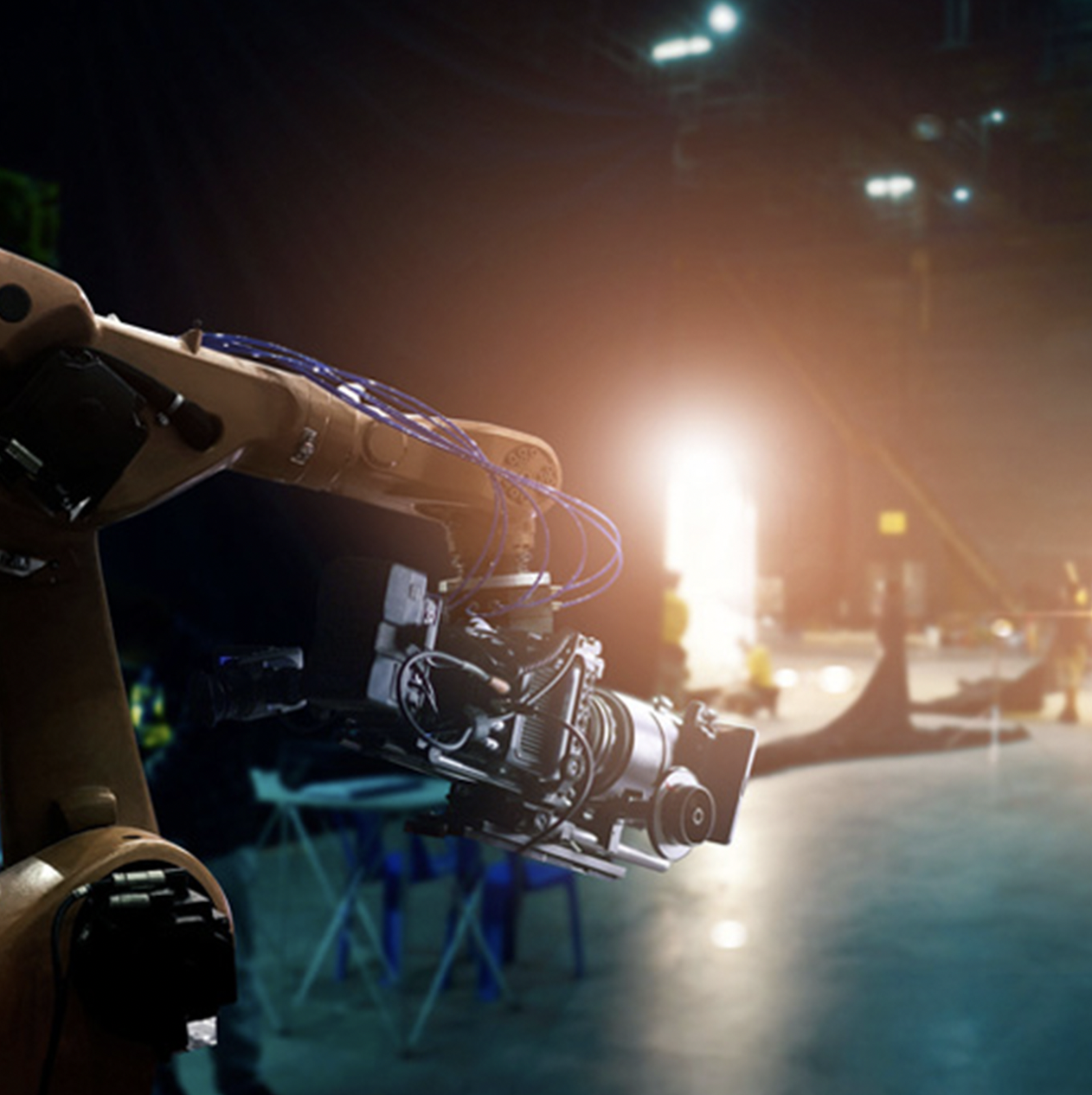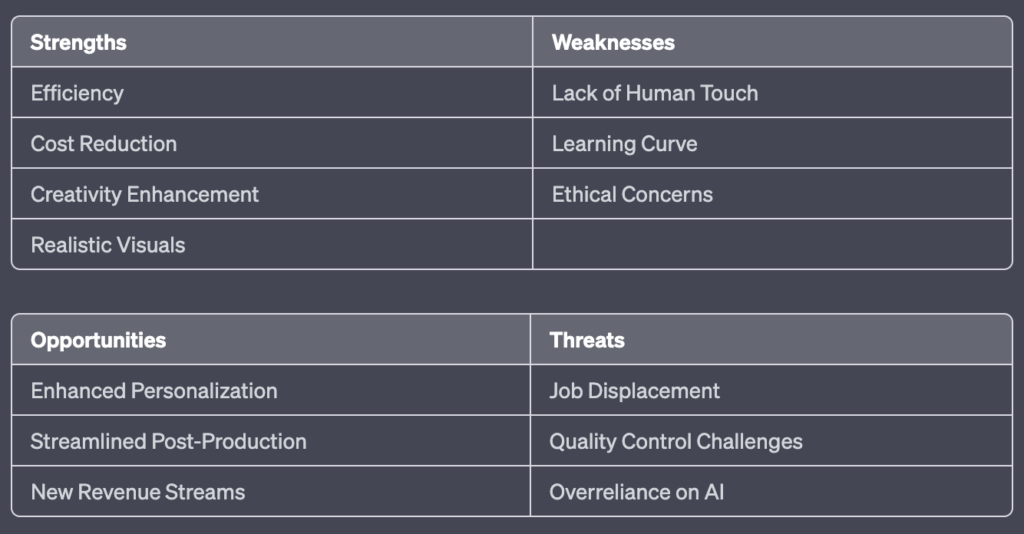

A Deeper Look Into AI’s Effect on the Video Production Industry and its Workforce
Generative AI, such as deep learning models, can have a significant impact on the video production industry. Here’s an analysis of the strengths, weaknesses, opportunities, and threats (SWOT) that generative AI poses to the industry:
Strengths of AI in Creative Fields
Efficiency: Generative AI can automate various aspects of video production, including editing, special effects, and post-production processes. This can save time and reduce human effort, increasing overall production efficiency.
Cost Reduction: By automating labor-intensive tasks, generative AI can potentially reduce production costs. Companies can allocate their resources more effectively and focus on other creative aspects of video production.
Creativity Enhancement: AI tools can assist video professionals by generating ideas, suggesting improvements, and providing new possibilities for creative expression. These tools can inspire new approaches and expand the creative boundaries of video production.
Realistic Visuals: Generative AI models can generate high-quality visual content, including realistic animations, virtual environments, and visual effects. This enables video producers to create visually stunning and immersive experiences.
Cost Reduction: By automating labor-intensive tasks, generative AI can potentially reduce production costs. Companies can allocate their resources more effectively and focus on other creative aspects of video production.
Creativity Enhancement: AI tools can assist video professionals by generating ideas, suggesting improvements, and providing new possibilities for creative expression. These tools can inspire new approaches and expand the creative boundaries of video production.
Realistic Visuals: Generative AI models can generate high-quality visual content, including realistic animations, virtual environments, and visual effects. This enables video producers to create visually stunning and immersive experiences.
Weaknesses of AI in Creative Fields
Lack of Human Touch: While generative AI can automate certain tasks, it may struggle to replicate the nuanced decision-making and emotional intelligence that human video professionals bring to their work. The human touch and subjective judgment may be missed in some aspects of video production.
Learning Curve: Adopting generative AI technologies requires a learning curve for video production professionals. They need to familiarize themselves with AI tools, adapt their workflows, and learn how to integrate AI-generated content seamlessly into their projects.
Ethical Concerns: Generative AI raises ethical concerns related to intellectual property, privacy, and authenticity. Misuse of AI-generated content, such as deepfakes, can lead to legal and ethical dilemmas, potentially damaging the credibility and trust of the video production industry.
Learning Curve: Adopting generative AI technologies requires a learning curve for video production professionals. They need to familiarize themselves with AI tools, adapt their workflows, and learn how to integrate AI-generated content seamlessly into their projects.
Ethical Concerns: Generative AI raises ethical concerns related to intellectual property, privacy, and authenticity. Misuse of AI-generated content, such as deepfakes, can lead to legal and ethical dilemmas, potentially damaging the credibility and trust of the video production industry.
Opportunities of AI in Creative Fields
Enhanced Personalization: Generative AI can assist in creating personalized video content tailored to individual viewers. It can analyze user preferences and behavior, generating video recommendations and personalized advertising.
Streamlined Post-Production: AI-powered video editing tools can automate tedious post-production tasks like color correction, noise reduction, and video stabilization, enabling faster turnaround times and improved quality.
New Revenue Streams: The application of generative AI in video production opens up opportunities for creating and selling AI-generated content, templates, or stock footage to other creators, thereby diversifying revenue streams.
Streamlined Post-Production: AI-powered video editing tools can automate tedious post-production tasks like color correction, noise reduction, and video stabilization, enabling faster turnaround times and improved quality.
New Revenue Streams: The application of generative AI in video production opens up opportunities for creating and selling AI-generated content, templates, or stock footage to other creators, thereby diversifying revenue streams.
Threats of AI in Creative Fields
Job Displacement: Automation through generative AI may lead to job displacement for certain video production roles, especially those involved in repetitive or low-skill tasks. Video professionals need to adapt and acquire new skills to stay relevant in an AI-driven industry.
Quality Control Challenges: While AI can generate content quickly, maintaining consistent quality can be a challenge. The output may lack the creative vision and attention to detail that human professionals provide, leading to potential inconsistencies or quality issues.
Overreliance on AI: Over-reliance on generative AI can stifle creativity and limit the exploration of alternative approaches. Relying solely on AI-generated content may result in a lack of diversity and originality in video productions.
Quality Control Challenges: While AI can generate content quickly, maintaining consistent quality can be a challenge. The output may lack the creative vision and attention to detail that human professionals provide, leading to potential inconsistencies or quality issues.
Overreliance on AI: Over-reliance on generative AI can stifle creativity and limit the exploration of alternative approaches. Relying solely on AI-generated content may result in a lack of diversity and originality in video productions.

It’s important to note that the impact of generative AI on the video production industry will depend on how the technology evolves and is adopted by professionals in the field.
To adapt to generative AI and leverage its potential, the video production and creative industries can consider the following strategies:
Embrace Collaboration: Instead of perceiving generative AI as a replacement for human creativity, view it as a collaborative tool. Encourage video production professionals to work alongside AI systems, leveraging the strengths of both humans and machines to achieve the best results.
Stay Updated and Educated: Video production professionals should actively stay updated on the latest advancements in generative AI. Attend workshops, conferences, and training programs to understand how AI can enhance their work and learn how to integrate AI tools into their existing workflows effectively.
Experiment and Explore: Encourage experimentation with generative AI tools and techniques. Video professionals can explore the capabilities of AI-generated content and experiment with incorporating it into their projects. This can help identify areas where AI can enhance efficiency and creativity.
Augment Existing Workflows: Identify specific tasks or processes within the video production workflow where generative AI can provide value. This can include automating repetitive tasks like video editing, visual effects, or content generation. By integrating AI tools into existing workflows, production processes can become more efficient and cost-effective.
Focus on Creativity and Innovation: Rather than relying solely on AI-generated content, encourage video professionals to focus on creativity, storytelling, and pushing the boundaries of their craft. Generative AI can be used as a tool to enhance creative ideas and provide inspiration, but human creativity remains essential in delivering unique and compelling video content.
Develop AI Ethics and Standards: Establish ethical guidelines and industry standards related to the use of generative AI in video production. This includes addressing concerns such as deepfakes, intellectual property rights, and privacy. Maintaining transparency and ethical practices will help build trust and credibility within the industry.
Adapt and Acquire New Skills: Video production professionals should be proactive in acquiring new skills that complement generative AI technologies. This can involve learning how to operate AI-powered tools, understanding AI concepts, and acquiring data analysis and interpretation skills. By expanding their skill sets, professionals can effectively collaborate with AI systems and take advantage of their capabilities.
Foster a Culture of Innovation: Encourage a culture of innovation and continuous learning within the video production industry. Foster an environment where professionals are encouraged to explore new technologies, experiment with AI tools, and share their knowledge and experiences with others.
By adopting these strategies, the video production and creative industries can adapt to generative AI, leverage its strengths, and navigate the evolving landscape of AI-driven content creation.
Stay Updated and Educated: Video production professionals should actively stay updated on the latest advancements in generative AI. Attend workshops, conferences, and training programs to understand how AI can enhance their work and learn how to integrate AI tools into their existing workflows effectively.
Experiment and Explore: Encourage experimentation with generative AI tools and techniques. Video professionals can explore the capabilities of AI-generated content and experiment with incorporating it into their projects. This can help identify areas where AI can enhance efficiency and creativity.
Augment Existing Workflows: Identify specific tasks or processes within the video production workflow where generative AI can provide value. This can include automating repetitive tasks like video editing, visual effects, or content generation. By integrating AI tools into existing workflows, production processes can become more efficient and cost-effective.
Focus on Creativity and Innovation: Rather than relying solely on AI-generated content, encourage video professionals to focus on creativity, storytelling, and pushing the boundaries of their craft. Generative AI can be used as a tool to enhance creative ideas and provide inspiration, but human creativity remains essential in delivering unique and compelling video content.
Develop AI Ethics and Standards: Establish ethical guidelines and industry standards related to the use of generative AI in video production. This includes addressing concerns such as deepfakes, intellectual property rights, and privacy. Maintaining transparency and ethical practices will help build trust and credibility within the industry.
Adapt and Acquire New Skills: Video production professionals should be proactive in acquiring new skills that complement generative AI technologies. This can involve learning how to operate AI-powered tools, understanding AI concepts, and acquiring data analysis and interpretation skills. By expanding their skill sets, professionals can effectively collaborate with AI systems and take advantage of their capabilities.
Foster a Culture of Innovation: Encourage a culture of innovation and continuous learning within the video production industry. Foster an environment where professionals are encouraged to explore new technologies, experiment with AI tools, and share their knowledge and experiences with others.
By adopting these strategies, the video production and creative industries can adapt to generative AI, leverage its strengths, and navigate the evolving landscape of AI-driven content creation.

